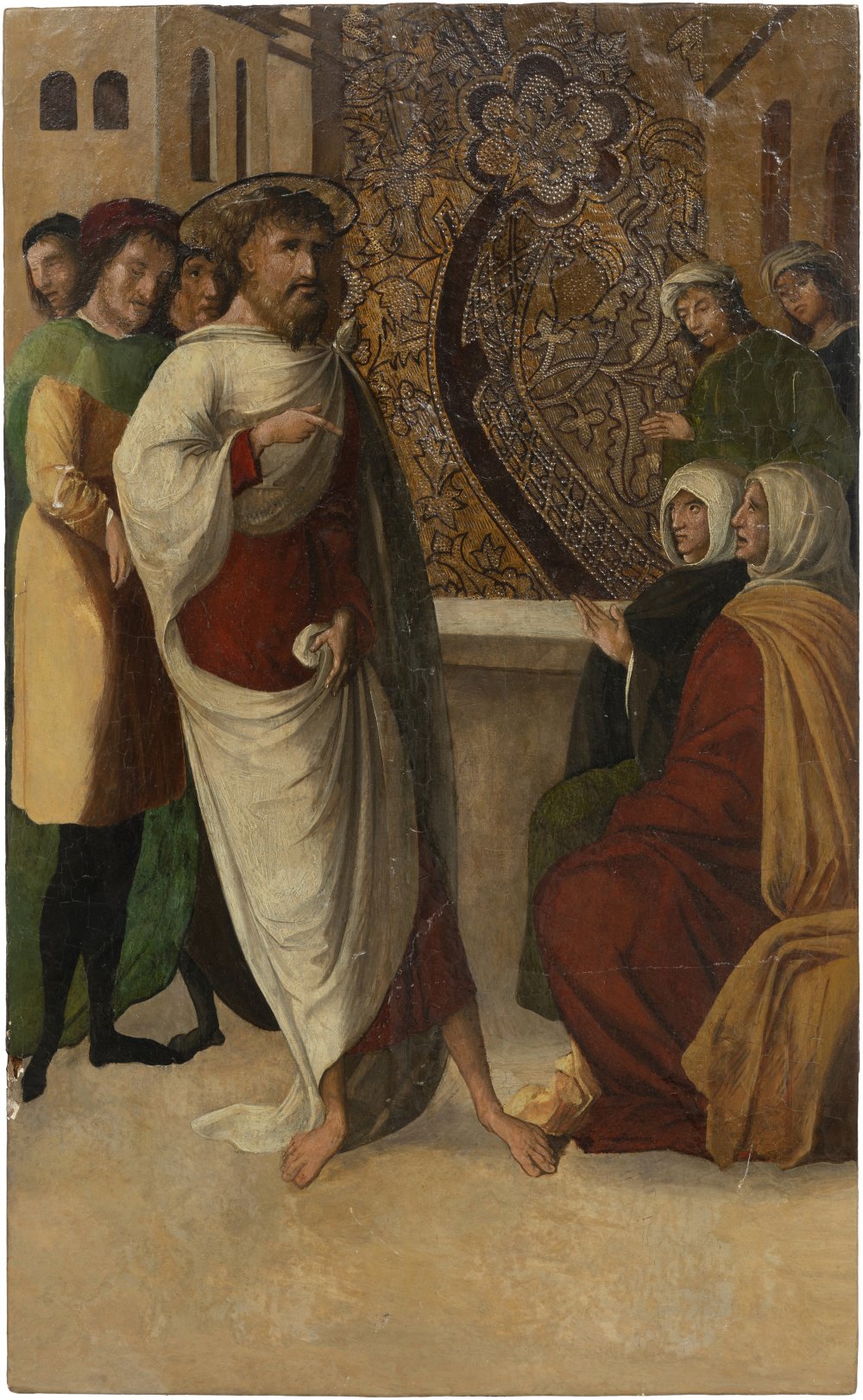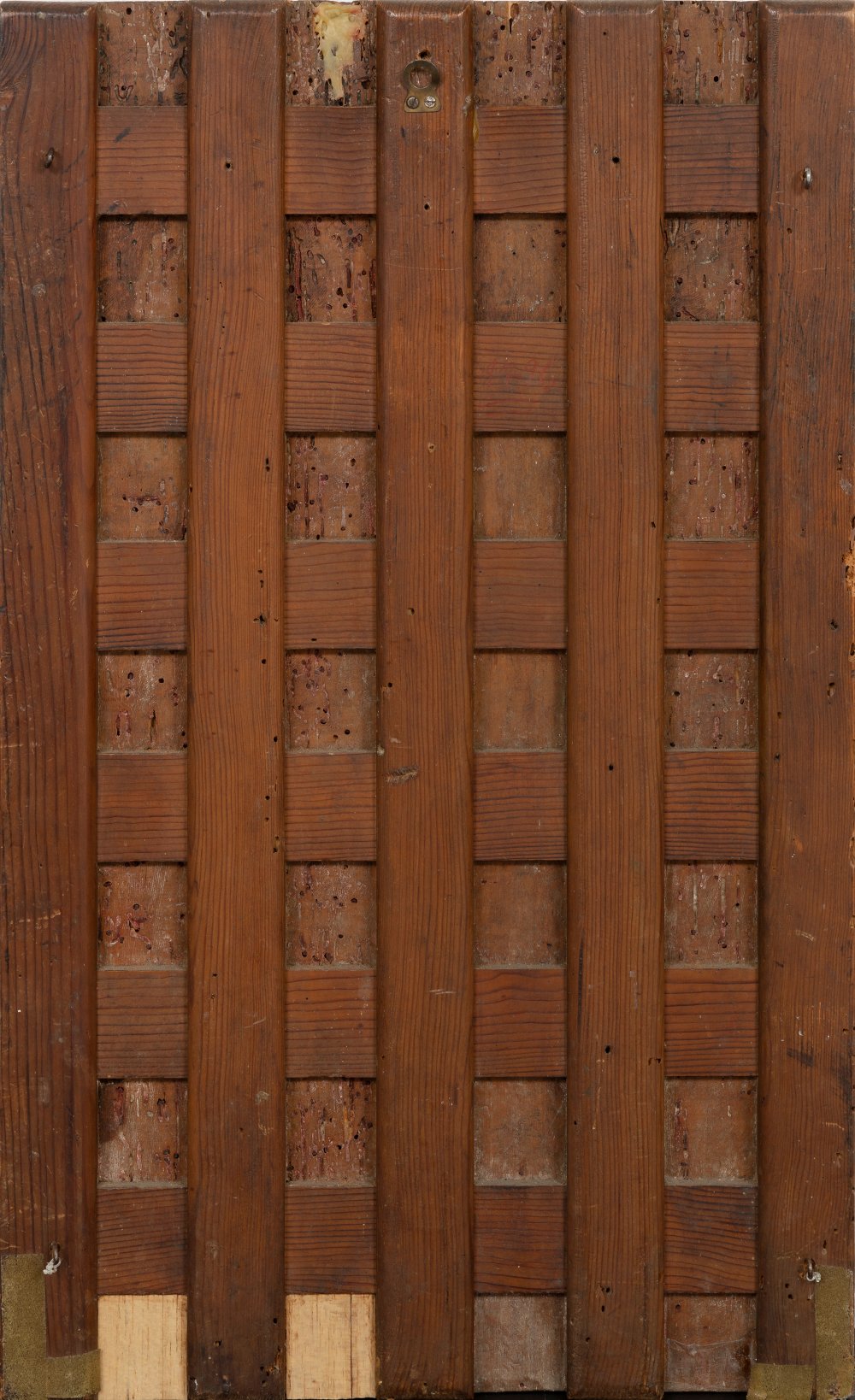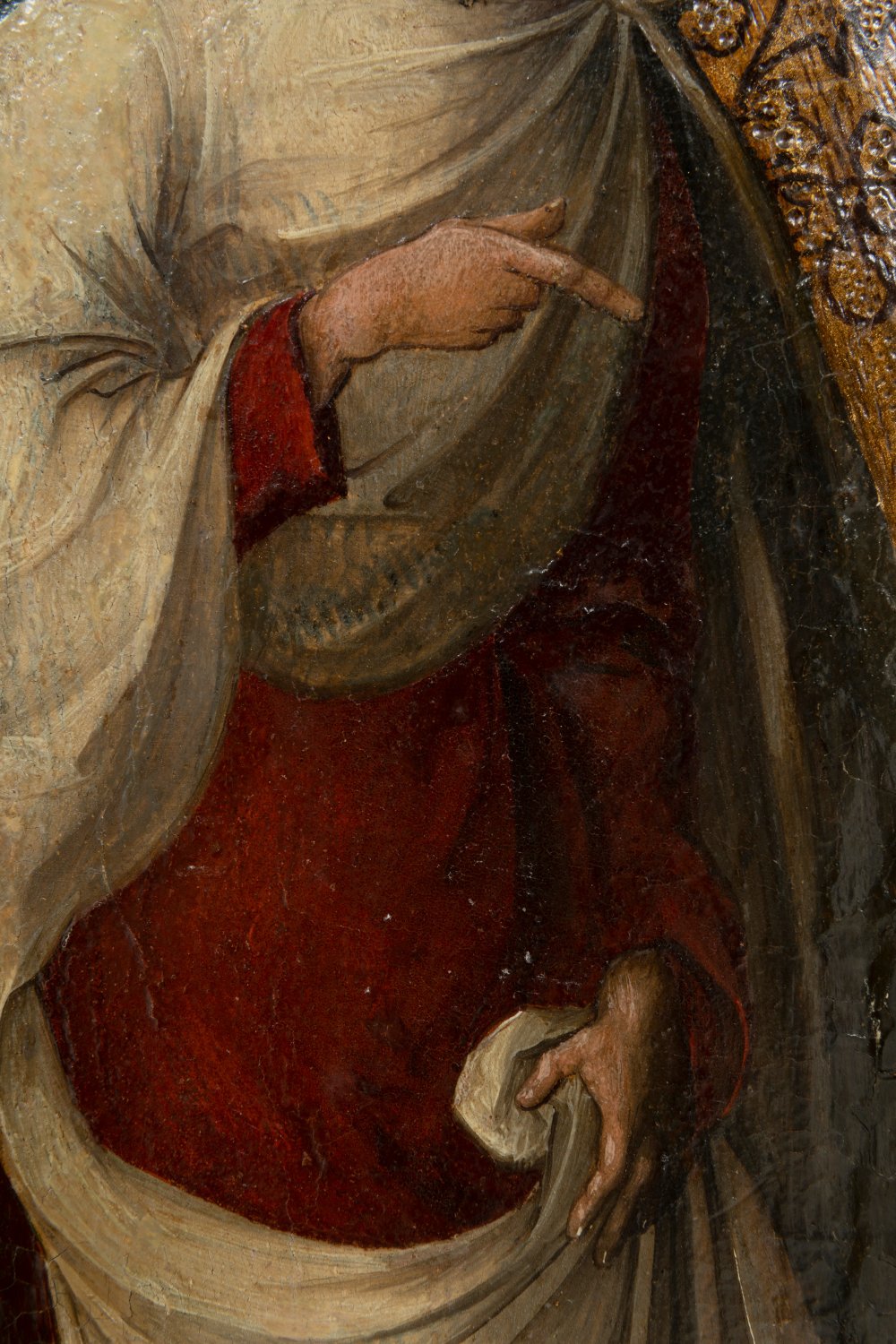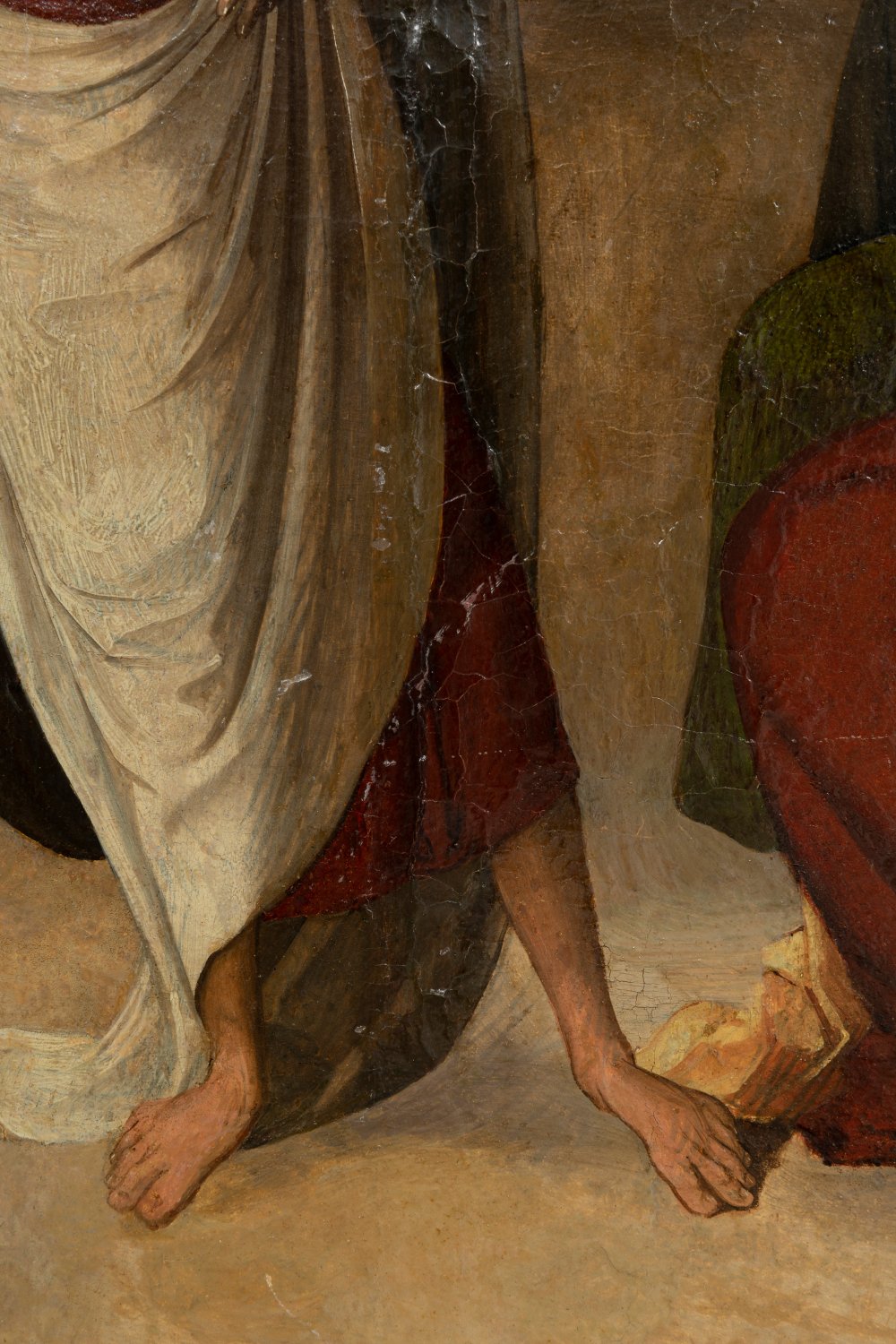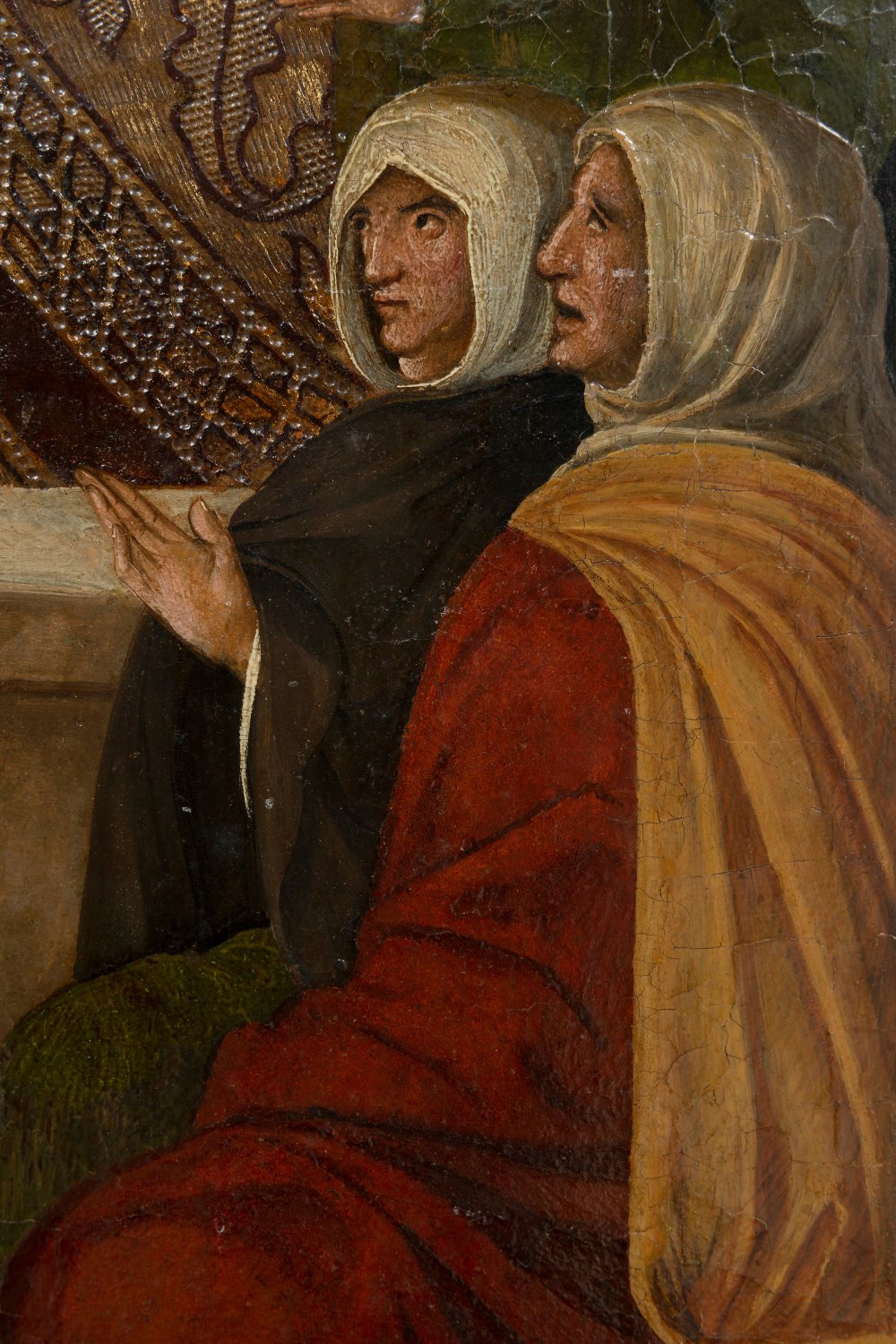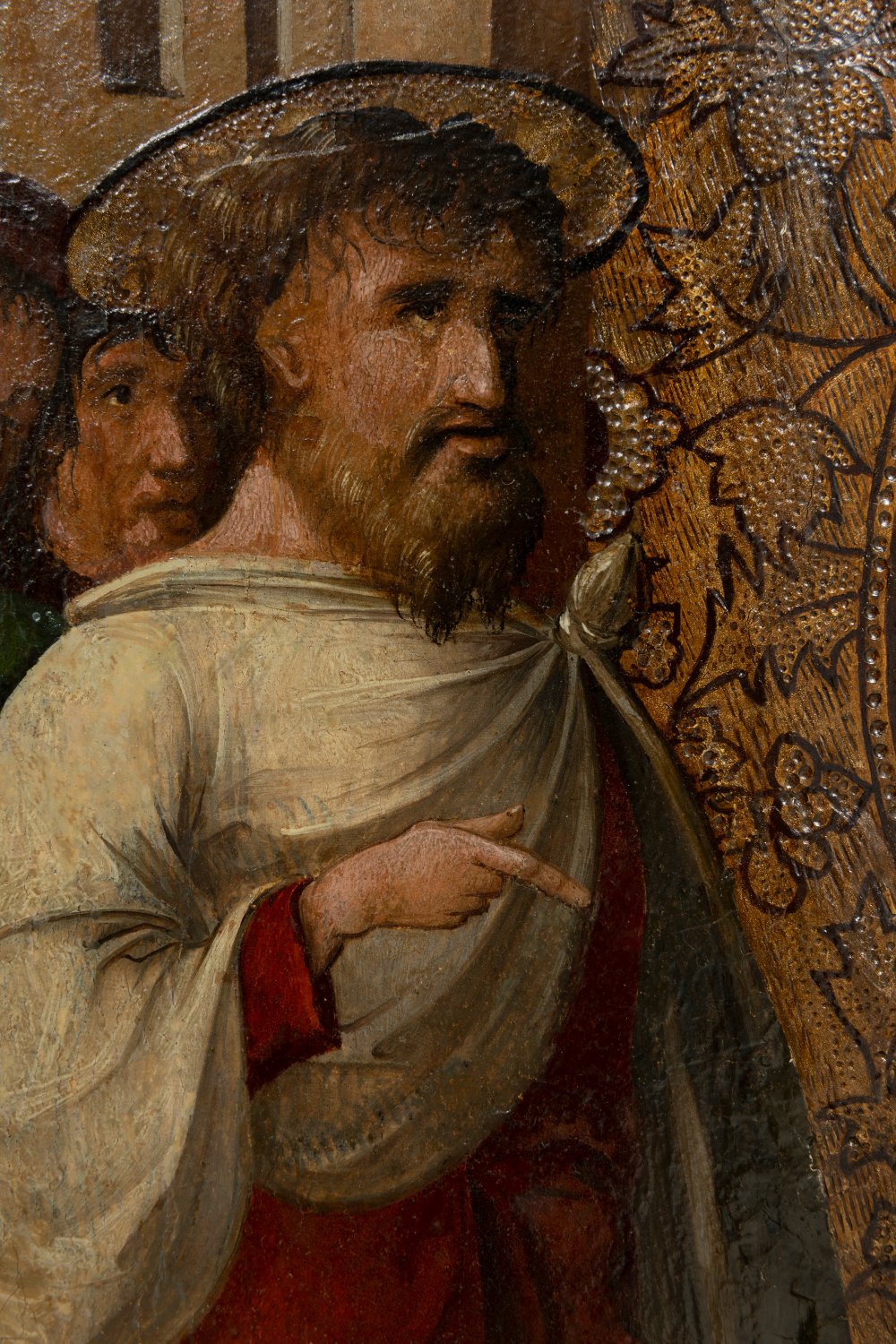2
Castilian school of the 16th century. Circle of PEDRO BERRUGUETE (Paredes de Nava, Palencia, ca.
1/7
Beschreibung
Castilian school of the 16th century. Circle of PEDRO BERRUGUETE (Paredes de Nava, Palencia, ca.1445/50 - Madrid?, 1503).
"Christ in the House of Martha and Mary".
Oil on pine panel. Gilded background.
Conservation: sealing, repainting, damage by xylophages.
Measurements: 64 x 39 x 3 cm.
The biblical scene illustrates a passage narrated in the Gospel of Luke, in which the arrival of Jesus to a village is described. He is received in the house of Martha and Mary. From the way in which the older woman questions him and the gesture that Christ returns, we can see that the scene depicts the moment when Martha complains that her sister left her to do the housework, and Jesus replies that she is worrying about unimportant things and exhorts her to seek eternal salvation. The panel belongs to the circle of Pedro Berruguete, one of the most outstanding painters of 15th-century Spain, the principal introducer of the Italian Renaissance into the Castilian school and thus situated in the transition between the Flemish-influenced Gothic style and the new Italianate Renaissance language. The stylised canons of each figure, the softness of their bodily and gestural grammar, the meticulous preciosity in the depiction of the trimmings and brocades, the expressiveness of the faces, the emphasis on drawing and the choice of a palette dominated by sienna and earthy tones are all attributes that can be found in numerous paintings by Berruguete.
Although we know very little documentary information about his life and work, we do know that he was born in the Palencia town of Paredes de Nava around 1445, if we assume, as is generally accepted, that he was the "peras Spagnolus" mentioned in Urbino in 1477. By then he was already a full resident of the Italian city, which is why he had to leave Castile for Italy at least in 1472. Berruguete was born into a family of noble origins and various hypotheses have been put forward regarding his artistic training. It is most likely that he trained in his native Castile with a master influenced by northern models, perhaps Justo de Gante. This training in the Flemish language has led some scholars to situate his training in Flanders, although given the importance of the Nordic influence in Spain at the time, a trip to the Low Countries was not a necessary condition for knowledge of the Flemish language. His training must have been completed in 1470 before leaving for Italy, as two panels survive from this period: "Historia de la Santa Cruz" (Museo Parroquial de Santa Eulalia, Paredes de Nava) and "La prueba del fuego" (Museo del Prado). He must have started his journey to Italy with Rome in mind, although he must have arrived in Urbino early, around 1473 or 1474. There he worked for Duke Federico de Montefeltro, producing works such as The Double Portrait of Federico de Montefeltro and his Son Ghibaldo (Gallerie Nazionale delle Marche, Urbino). He must have subsequently returned to Castile and Ceán Bermúdez locates him in Toledo in 1483, as documentation indicates that he was at that date working on the paintings of the Old Tabernacle in Toledo cathedral, now lost.
"Christ in the House of Martha and Mary".
Oil on pine panel. Gilded background.
Conservation: sealing, repainting, damage by xylophages.
Measurements: 64 x 39 x 3 cm.
The biblical scene illustrates a passage narrated in the Gospel of Luke, in which the arrival of Jesus to a village is described. He is received in the house of Martha and Mary. From the way in which the older woman questions him and the gesture that Christ returns, we can see that the scene depicts the moment when Martha complains that her sister left her to do the housework, and Jesus replies that she is worrying about unimportant things and exhorts her to seek eternal salvation. The panel belongs to the circle of Pedro Berruguete, one of the most outstanding painters of 15th-century Spain, the principal introducer of the Italian Renaissance into the Castilian school and thus situated in the transition between the Flemish-influenced Gothic style and the new Italianate Renaissance language. The stylised canons of each figure, the softness of their bodily and gestural grammar, the meticulous preciosity in the depiction of the trimmings and brocades, the expressiveness of the faces, the emphasis on drawing and the choice of a palette dominated by sienna and earthy tones are all attributes that can be found in numerous paintings by Berruguete.
Although we know very little documentary information about his life and work, we do know that he was born in the Palencia town of Paredes de Nava around 1445, if we assume, as is generally accepted, that he was the "peras Spagnolus" mentioned in Urbino in 1477. By then he was already a full resident of the Italian city, which is why he had to leave Castile for Italy at least in 1472. Berruguete was born into a family of noble origins and various hypotheses have been put forward regarding his artistic training. It is most likely that he trained in his native Castile with a master influenced by northern models, perhaps Justo de Gante. This training in the Flemish language has led some scholars to situate his training in Flanders, although given the importance of the Nordic influence in Spain at the time, a trip to the Low Countries was not a necessary condition for knowledge of the Flemish language. His training must have been completed in 1470 before leaving for Italy, as two panels survive from this period: "Historia de la Santa Cruz" (Museo Parroquial de Santa Eulalia, Paredes de Nava) and "La prueba del fuego" (Museo del Prado). He must have started his journey to Italy with Rome in mind, although he must have arrived in Urbino early, around 1473 or 1474. There he worked for Duke Federico de Montefeltro, producing works such as The Double Portrait of Federico de Montefeltro and his Son Ghibaldo (Gallerie Nazionale delle Marche, Urbino). He must have subsequently returned to Castile and Ceán Bermúdez locates him in Toledo in 1483, as documentation indicates that he was at that date working on the paintings of the Old Tabernacle in Toledo cathedral, now lost.
Auktionsdetails
Versand
AGB & Wichtige Informationen
Stellen Sie dem Verkäufer eine Frage
Castilian school of the 16th century. Circle of PEDRO BERRUGUETE (Paredes de Nava, Palencia, ca.1445/50 - Madrid?, 1503).
"Christ in the House of Martha and Mary".
Oil on pine panel. Gilded background.
Conservation: sealing, repainting, damage by xylophages.
Measurements: 64 x 39 x 3 cm.
The biblical scene illustrates a passage narrated in the Gospel of Luke, in which the arrival of Jesus to a village is described. He is received in the house of Martha and Mary. From the way in which the older woman questions him and the gesture that Christ returns, we can see that the scene depicts the moment when Martha complains that her sister left her to do the housework, and Jesus replies that she is worrying about unimportant things and exhorts her to seek eternal salvation. The panel belongs to the circle of Pedro Berruguete, one of the most outstanding painters of 15th-century Spain, the principal introducer of the Italian Renaissance into the Castilian school and thus situated in the transition between the Flemish-influenced Gothic style and the new Italianate Renaissance language. The stylised canons of each figure, the softness of their bodily and gestural grammar, the meticulous preciosity in the depiction of the trimmings and brocades, the expressiveness of the faces, the emphasis on drawing and the choice of a palette dominated by sienna and earthy tones are all attributes that can be found in numerous paintings by Berruguete.
Although we know very little documentary information about his life and work, we do know that he was born in the Palencia town of Paredes de Nava around 1445, if we assume, as is generally accepted, that he was the "peras Spagnolus" mentioned in Urbino in 1477. By then he was already a full resident of the Italian city, which is why he had to leave Castile for Italy at least in 1472. Berruguete was born into a family of noble origins and various hypotheses have been put forward regarding his artistic training. It is most likely that he trained in his native Castile with a master influenced by northern models, perhaps Justo de Gante. This training in the Flemish language has led some scholars to situate his training in Flanders, although given the importance of the Nordic influence in Spain at the time, a trip to the Low Countries was not a necessary condition for knowledge of the Flemish language. His training must have been completed in 1470 before leaving for Italy, as two panels survive from this period: "Historia de la Santa Cruz" (Museo Parroquial de Santa Eulalia, Paredes de Nava) and "La prueba del fuego" (Museo del Prado). He must have started his journey to Italy with Rome in mind, although he must have arrived in Urbino early, around 1473 or 1474. There he worked for Duke Federico de Montefeltro, producing works such as The Double Portrait of Federico de Montefeltro and his Son Ghibaldo (Gallerie Nazionale delle Marche, Urbino). He must have subsequently returned to Castile and Ceán Bermúdez locates him in Toledo in 1483, as documentation indicates that he was at that date working on the paintings of the Old Tabernacle in Toledo cathedral, now lost.
"Christ in the House of Martha and Mary".
Oil on pine panel. Gilded background.
Conservation: sealing, repainting, damage by xylophages.
Measurements: 64 x 39 x 3 cm.
The biblical scene illustrates a passage narrated in the Gospel of Luke, in which the arrival of Jesus to a village is described. He is received in the house of Martha and Mary. From the way in which the older woman questions him and the gesture that Christ returns, we can see that the scene depicts the moment when Martha complains that her sister left her to do the housework, and Jesus replies that she is worrying about unimportant things and exhorts her to seek eternal salvation. The panel belongs to the circle of Pedro Berruguete, one of the most outstanding painters of 15th-century Spain, the principal introducer of the Italian Renaissance into the Castilian school and thus situated in the transition between the Flemish-influenced Gothic style and the new Italianate Renaissance language. The stylised canons of each figure, the softness of their bodily and gestural grammar, the meticulous preciosity in the depiction of the trimmings and brocades, the expressiveness of the faces, the emphasis on drawing and the choice of a palette dominated by sienna and earthy tones are all attributes that can be found in numerous paintings by Berruguete.
Although we know very little documentary information about his life and work, we do know that he was born in the Palencia town of Paredes de Nava around 1445, if we assume, as is generally accepted, that he was the "peras Spagnolus" mentioned in Urbino in 1477. By then he was already a full resident of the Italian city, which is why he had to leave Castile for Italy at least in 1472. Berruguete was born into a family of noble origins and various hypotheses have been put forward regarding his artistic training. It is most likely that he trained in his native Castile with a master influenced by northern models, perhaps Justo de Gante. This training in the Flemish language has led some scholars to situate his training in Flanders, although given the importance of the Nordic influence in Spain at the time, a trip to the Low Countries was not a necessary condition for knowledge of the Flemish language. His training must have been completed in 1470 before leaving for Italy, as two panels survive from this period: "Historia de la Santa Cruz" (Museo Parroquial de Santa Eulalia, Paredes de Nava) and "La prueba del fuego" (Museo del Prado). He must have started his journey to Italy with Rome in mind, although he must have arrived in Urbino early, around 1473 or 1474. There he worked for Duke Federico de Montefeltro, producing works such as The Double Portrait of Federico de Montefeltro and his Son Ghibaldo (Gallerie Nazionale delle Marche, Urbino). He must have subsequently returned to Castile and Ceán Bermúdez locates him in Toledo in 1483, as documentation indicates that he was at that date working on the paintings of the Old Tabernacle in Toledo cathedral, now lost.
29th December - Old Masters
Auktionsdatum
Ort der Versteigerung
Aragón 346, Barcelona
Calle Velázquez 7, Madrid
Carrer de Cirilo Amorós 55, Valencia
Barcelona
08009
Spain
Generelle Versandinformationen vom Auktionshaus verfügbar
Setdart offers Worldwide shipping
PICK UP IN ROOM: You can come and pick up your lots in our offices (Barcelona, Madrid or Valencia). At the moment of the withdrawal, you will be able to accept the current conditions of the lot by means of a document that you will sign.
YOU CAN SEND ANOTHER PERSON TO PICK UP: This person must present a signed authorization that you can find in our web page by accessing from BUY AT SETDART- LOGISTICS-DOWNLOAD AUTHORIZATION DOCUMENT. You can also send an e-mail with the requested data in AUTHORIZATION DOCUMENT to admin@setdart.com
Wichtige Informationen
25% buyer´s premium
21% buyer´s premium at www.setdart.com















